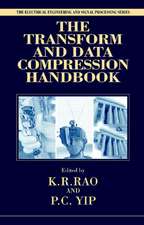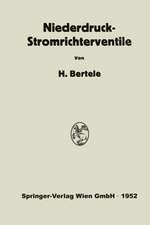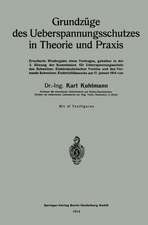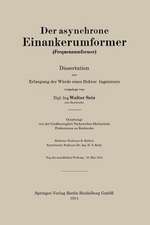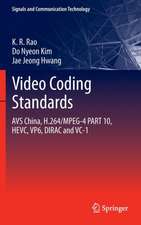Digital Video Image Quality and Perceptual Coding: Signal Processing and Communications
Editat de H.R. Wu, K. R. Raoen Limba Engleză Hardback – 18 noi 2005
This book is divided broadly into three parts. First, it introduces the fundamental theory, concepts, principles, and techniques underlying the field, such as the basics of compression, HVS modeling, and coding artifacts associated with current well-known techniques. The next section focuses on picture quality assessment criteria; subjective and objective methods and metrics, including vision model based digital video impairment metrics; testing procedures; and international standards regarding image quality. Finally, practical applications come into focus, including digital image and video coder designs based on the HVS as well as post-filtering, restoration, error correction, and concealment techniques.
The permeation of digital images and video throughout the world cannot be understated. Nor can the importance of preserving quality while using minimal storage space, and Digital Video Image Quality and Perceptual Coding provides the tools necessary to accomplish this goal.
Instructors and lecturers wishing to make use of this work as a textbook can download a presentation of 786 slides in PDF format organized to augment the text.
accompany our book
(H.R. Wu and K.R. Rao, Digital Video Image Quality and Perceptual Coding, CRC Press (ISBN: 0-8247-2777-0), Nov. 2005)
for lecturers or instructor to use for their classes if they use the book.
Din seria Signal Processing and Communications
- 29%
 Preț: 1409.74 lei
Preț: 1409.74 lei - 27%
 Preț: 997.51 lei
Preț: 997.51 lei - 15%
 Preț: 568.28 lei
Preț: 568.28 lei - 9%
 Preț: 1038.62 lei
Preț: 1038.62 lei - 29%
 Preț: 1198.13 lei
Preț: 1198.13 lei - 29%
 Preț: 1195.61 lei
Preț: 1195.61 lei - 18%
 Preț: 1941.82 lei
Preț: 1941.82 lei - 18%
 Preț: 1937.07 lei
Preț: 1937.07 lei - 18%
 Preț: 1935.02 lei
Preț: 1935.02 lei - 18%
 Preț: 1347.78 lei
Preț: 1347.78 lei - 28%
 Preț: 831.98 lei
Preț: 831.98 lei - 33%
 Preț: 954.06 lei
Preț: 954.06 lei - 33%
 Preț: 953.26 lei
Preț: 953.26 lei - 33%
 Preț: 1204.29 lei
Preț: 1204.29 lei - 34%
 Preț: 1510.34 lei
Preț: 1510.34 lei - 34%
 Preț: 1338.30 lei
Preț: 1338.30 lei
Preț: 1562.67 lei
Preț vechi: 1905.70 lei
-18% Nou
Puncte Express: 2344
Preț estimativ în valută:
299.11€ • 325.01$ • 251.42£
299.11€ • 325.01$ • 251.42£
Carte tipărită la comandă
Livrare economică 21 aprilie-05 mai
Preluare comenzi: 021 569.72.76
Specificații
ISBN-13: 9780824727772
ISBN-10: 0824727770
Pagini: 636
Ilustrații: 310 equations; 88 Halftones, black and white; 44 Tables, black and white; 153 Illustrations, black and white
Dimensiuni: 152 x 229 x 39 mm
Greutate: 0.97 kg
Ediția:1
Editura: CRC Press
Colecția CRC Press
Seria Signal Processing and Communications
ISBN-10: 0824727770
Pagini: 636
Ilustrații: 310 equations; 88 Halftones, black and white; 44 Tables, black and white; 153 Illustrations, black and white
Dimensiuni: 152 x 229 x 39 mm
Greutate: 0.97 kg
Ediția:1
Editura: CRC Press
Colecția CRC Press
Seria Signal Processing and Communications
Public țintă
ProfessionalCuprins
PICTURE CODING AND HUMAN VISUAL SYSTEM FUNDAMENTALS. Digital Picture Compression and Coding Structure. Fundamentals of Human Vision and Vision Modeling. Coding Artifacts and Visual Distortions. PICTURE QUALITY ASSESSMENT AND METRICS. Video Quality Testing. Perceptual Video Quality Metrics-A Review. Philosophy of Picture Quality Scale. Structural Similarity Based Image Quality Assessment. Vision Model Based Digital Video Impairment Metrics. Computational Models for Just-Noticeable Difference. No-Reference Quality Metric for Degraded and Enhanced Video. Video Quality Experts Group. PERCEPTUAL CODING AND PROCESSING OF DIGITAL PICTURES. HVS Based Perceptual Video Encoders. Perceptual Image Coding. Foveated Image and Video Coding. Artifact Reduction by Post-Processing in Image Compression. Reduction of Color Bleeding in DCT Block-Coded Video. Error Resilience for Video Coding Service. Critical Issues and Challenges. Appendix: VQM Performance Metrics. Index.
Descriere
This book addresses the issue of human visual system (HVS)-based perceptual quantitative quality metrics for digitally coded image and video as well as the issue of perceptual image and video coding. Introducing basic techniques, the text presents standard and popular coding structures, gives a classification and analysis of various coding artifacts, and provides performance measures. It further discusses subjective assessment methods, quantitative quality metrics, and test criteria. There is additional coverage on HVS-based digital image and video coder designs. The authors also highlight challenges facing future research. Instructors wishing to use this work as a textbook can download a presentation of 786 slides in PDF format.




